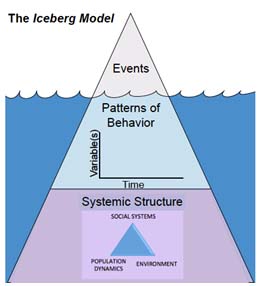 
|
|||
|
|
|
Home > Curriculum > Complex Systems > Populationdynamics
CLE Curriculum: Population Dynamics Population Dynamics
Most of us are familiar with Santayana's famous quote. "Those who do not remember the past are condemned to repeat it." But what does this mean, in practical terms, for how we teach history? Are there opportunities to help our students better recognize and apply lessons from the past to understand the present and what may happen in the future? As systems thinkers and dynamic modelers, we have unique tools and perspectives to foster deep learning. Consider our "Iceberg Model". Some may apply Santayana's warning to particular EVENTS. As systems thinkers, we look at longer-term behaviors over time to find recurring PATTERNS. These generic patterns appear as periods of economic boom and bust, war and peace, social and political upheaval. We recognize that underlying these patterns are closed networks of structured relationships or SYSTEMS. Finally, we know that these systems continue to function in the present, informing patterns that impact today's world and future events.
Simulations and Lessons Part A: Push and Pull Forces in Settling America Complex Systems: Cause/Effect, Cause Within System
Part B: Push and Pull Forces in U.S. Colonial History Complex Systems: Cause/Effect, Cause Within System
Part C: U.S. Urbanization from 1820-1920 Complex Systems: Cause/Effect, Short Term/Long Term
Part D: America's Baby Boom and Global Youth Bulges Complex Systems: Cause/Effect, Cause Within System, Burdens Shifted
Introduction to Population Dynamics: A Systems-Based High School Curriculum This video introduces the simulations. These simulations use systems thinking and dynamic modeling tools to expose different patterns of population growth associated with demographic systems (birth and death rates, migration), environmental resources and social systems. As many of these systems structures and closed relationships persist, they continue to shape the present and possible future developments.
|
|



 The four simulations of the Population Dynamics series are designed to supplement existing high school history curricula and be largely self-directed by students outside of class time. They are intended to introduce students to a variety of systems tools (behavior-over-time graphs, stock/flow maps, models/simulations) along with primary and secondary historical resources. This unique combination of tools offers students opportunities to actively reconstruct patterns of change in the past based on structural relationships that continue to exist and influence the present and future. Each of the four simulations below examines an important period of development within American history.
The four simulations of the Population Dynamics series are designed to supplement existing high school history curricula and be largely self-directed by students outside of class time. They are intended to introduce students to a variety of systems tools (behavior-over-time graphs, stock/flow maps, models/simulations) along with primary and secondary historical resources. This unique combination of tools offers students opportunities to actively reconstruct patterns of change in the past based on structural relationships that continue to exist and influence the present and future. Each of the four simulations below examines an important period of development within American history. 